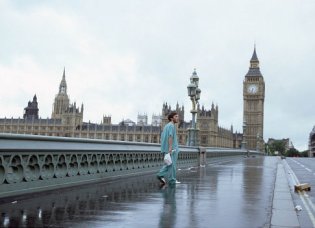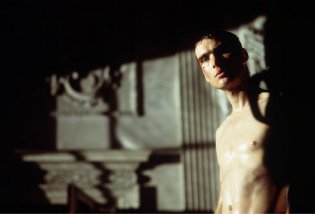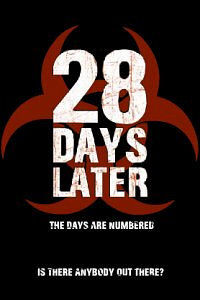|
28 Days
Later
Some say
the world will end in fire. Some say it will end in ice. But
I'm holding out for it ending with an infected monkey bite.
Apparently
so are screenwriter Alex Garland and director Danny Boyle.
For it is just such a calamity that tips the dominos of disaster
in 28 Days Later, their intriguing riff on the zombie
genre with artier concerns on its mind.
We're
not talking Sumatran Rat-Monkeys, either, of the variety that
started all the trouble in Dead Alive (aka Braindead,
for our non-U.S. readers). No, it all starts with your standard
laboratory chimpanzee.
A group
of animal rights activists break in to a compound playing
around with various viruses and their effects on primates.
Sure, these young tree-huggers are well-meaning, but their
may be some sly commentary in their willingness to kill in
order to liberate their hairier brethren. They're also not
willing to listen to the pleas of the young lab assistant
begging them not to release these monkeys. Why not liberate
them? Because they've literally been infected with Rage, a
virus that causes homicidal impulses that supersede all other
instincts. (Although it may be more fair to say that the virus
eliminates all impulses but the homicidal one - Garland and
Boyle clearly have a point to make about the basic savagery
of man.)
Within
seconds of opening a cage, a chimp attacks, and a human has
been infected. This Rage is so contagious that the slightest
blood to blood contact triggers it to full sickness within
a minute. And then, 28 days later…
 Bicycle
messenger Jim (Cillian Murphy) awakens from a coma. His hospital
room has been completely abandoned, leaving him au naturel
in a ghost city. From chimpanzee to man, it's all still clearly
just the naked ape. Bicycle
messenger Jim (Cillian Murphy) awakens from a coma. His hospital
room has been completely abandoned, leaving him au naturel
in a ghost city. From chimpanzee to man, it's all still clearly
just the naked ape.
After
finding some scrubs and busting open a Pepsi machine for supplies,
Jim wanders the eerily silent city of London. Littered with
corpses and trash (the streets, not Jim himself), he can find
no clues as to what happened, until he blunders into a church.
Naturally, he yells "helloooo…" And we all know what a mistake
that is in a horror film. Sure enough, amidst a pile
of bodies in the chapel, something stirs.
Unlike
most visions of the undead, Boyle's zombies move at an almost
inhuman speed. Logical, really, because technically, they're
not dead. Still living, they exist only to kill, though curiously,
only to kill those not infected. And they don't eat, either.
The presence of normal humans just pisses them off so much
they can't think about anything else.
Despite
their apparent mindlessness, they even seem capable of working
together to herd panicked humans together for the slaughter,
and occasionally even know when it's just no good to continue
trying to outrun a car. Good thing for our heroes.
Because
the rules of the convention say that a group of survivors
must band together, Jim does encounter others. First come
Selena (Naomie Harris) and Mark (Noah Huntley), who rescue
Jim from that church in a blaze of glory. Through them, Jim
(and the audience) learns just what the heck really happened,
though as filmgoers, we could already piece it together. None
of their lessons stick, though, which soon enough costs them
the life of Mark.
From
there, however, the circumstantial couple meet Frank (Brendan
Gleeson) and Hannah (Megan Burns), a father and daughter living
in a high-rise, who leave the Christmas lights on as a symbol
of hope in a desolate city. But can there really be hope?
Even as dwindling supplies force them to think of fleeing
(knowing that there's really nowhere to run), they pick up
a radio signal from the north. A military unit broadcasts
a message of salvation, if only the survivors can get out
of the city and to a heavily fortified country estate.
And of
course, once there, things aren't quite as advertised, and
the difference between the infected and the healthy may become
only obvious in the color of their eyes.
28
Days Later plays with many of the conventions set forth
by George Romero in his Dead trilogy. In fact, the
whole movie encompasses said trilogy, including a brief moment
of consumerism run rampant. But while the film is effective
in many ways, it doesn't quite have that lingering dread that
would vault it into classic territory, preferring to exercise
a bit of restraint. For a zombie riff, it's curiously low
on the gore.
What
it does have, however, is strong characterization. Even as
Garland's script reduces the military men to stereotypes,
Boyle allows for Christopher Eccleston's Major West to seem
almost reasonable in his plans to maintain civilization. In
the position of "conscientious objector," Sergeant Farrell
(Stuart McQuarrie) prophesies where the movie is going, a
prophecy that will likely occur to you the second you understand
just what the limitations of Rage are. But McQuarrie plays
it with a conviction that makes you overlook the obvious:
this guy is just asking to die.
 The
main leads are mostly powerful, though Murphy has a purposeful
slow-wittedness about him that sometimes gets annoying. If
this is the hope of humanity, intellectuals have to fear the
future. The
main leads are mostly powerful, though Murphy has a purposeful
slow-wittedness about him that sometimes gets annoying. If
this is the hope of humanity, intellectuals have to fear the
future.
Out of
necessity, Boyle filmed 28 Days Later in Digital Video.
As a practical method, it allowed for quick shot set ups,
which gave Boyle a better chance at capturing a deserted early
Sunday morning London. As an artistic decision, it also gives
the audience more of a voyeuristic feel. There's little difference
between the film as a whole and the newsreel footage that
a chimpanzee has been forced to watch (a la A Clockwork
Orange) at the beginning of the film. It makes us somehow
more complicit, like we're watching through the eyes of something
that may burst through the camera and attack the characters
at any moment.
Boyle
tacks on a perhaps too cheerful denoument, but it does
make sense by the rules of the story, even if it's at odds
with the overall tone. 28 Days Later still manages
to reach what the best horror tries to do: not just scare
us, but actually say something.
If you
want mindless, go see Full Throttle. But if you actually
want something of depth that will still entertain you, see
28 Days Later.
What's
It Worth? $7
|

 Bicycle
messenger Jim (Cillian Murphy) awakens from a coma. His hospital
room has been completely abandoned, leaving him au naturel
in a ghost city. From chimpanzee to man, it's all still clearly
just the naked ape.
Bicycle
messenger Jim (Cillian Murphy) awakens from a coma. His hospital
room has been completely abandoned, leaving him au naturel
in a ghost city. From chimpanzee to man, it's all still clearly
just the naked ape.
 The
main leads are mostly powerful, though Murphy has a purposeful
slow-wittedness about him that sometimes gets annoying. If
this is the hope of humanity, intellectuals have to fear the
future.
The
main leads are mostly powerful, though Murphy has a purposeful
slow-wittedness about him that sometimes gets annoying. If
this is the hope of humanity, intellectuals have to fear the
future.





